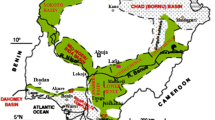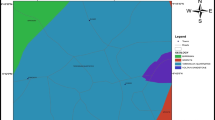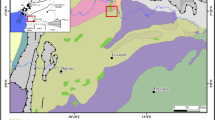Abstract
Environmental geochemistry classifies elements into essential, non-essential and toxic elements in relationship to human health. To assess the environmental impact of mining at Datoko-Shega area, the distributions and concentrations of trace elements in stream sediments and soil samples were carried out. X-ray fluorescence analytical technique was used to measure the major and trace element concentrations in sediments and modified fire assay absorption spectrometry in soils. The results showed general depletion of major elements except titanium oxide (TiO2) compared to the average crustal concentrations. The retention of TiO2 at the near surface environment probably was due to the intense tropical weathering accompanied by the removal of fine sediments and soil fractions during the harmattan season by the dry north-east trade winds and sheet wash deposits formed after flash floods. The results also showed extreme contamination of selenium (Se), cadmium (Cd) and mercury (Hg), plus strong contaminations of arsenic (As) and chromium (Cr) in addition to moderate contamination of lead (Pb) in the trace element samples relative to crustal averages in the upper continental crust. However Hg, Pb and Cd concentrations tend to be high around the artisanal workings. It was recognised from the analysis of the results that the artisanal mining activity harnessed and introduces some potentially toxic elements such as Hg, Cd and Pb mostly in the artisan mine sites. But the interpretation of the trace element data thus invalidates the elevation of As concentrations to be from the mine operations. It consequently noticed As values in the mine-impacted areas to be similar or sometimes lower than As values in areas outside the mine sites from the stream sediment results.










Similar content being viewed by others
References
Anand, R. R. (2001). Evolution, classification and use of ferruginous regolith materials in gold exploration Yilgarn Craton, Western Australia. Geochemistry: Exploration, Environment, Analysis, 1, 221–236.
Apea, O. B. (2012). Modelling the role of humid substances in the distribution of trace metals in selected ecosystems in Ghana. Unpublished PhD dissertation, Kwame Nkrumah University of Science and Technology Kumasi, Ghana.
Arhin, E., & Nude, P. M. (2009). Significance of regolith mapping and its implication for gold exploration in northern Ghana: A case study at Tinga and Kunche. Geochemistry: Exploration, Environment, Analysis, 9, 63–69.
Boateng, E., Dowuona, G. N. N., M. Nude, P. M., Foli, G., Gyekye P., and Hashim, M. (2012). Geochemical assessment of the impact of mine tailings reclamation on the quality of soils at anglogold concession, Obuasi, Ghana. Research Journal of Environmental and Earth Sciences 4(4): pp. 466–474, 2012 ISSN: 2041–0492.
Dickson, K. B. (1972). A historical geography of Ghana. Journal of Asian and African Studies, Centre for Global Metallogeny, 7, 253–255.
Foli, G., Nude, P. M., and Ohene O. Boansi (2012). Geochemical characteristics of soils from selected districts in the upper east region, Ghana: Implications for trace element pollution and enrichment. Research Journal of Environmental and Earth Sciences, 4(2): pp. 186–195, ISSN: 2041–0492. Maxwell Scientific Organization.
Griffis, J., Barning, K., Agezo, F. L., & Akosa, F. (2002). Gold deposits of Ghana, prepared on behalf of Ghana mineral commission. Ghana: Accra. p. 432.
Kesse, G. O. (1985). The rock and mineral resources of Ghana. Rotterdam, Netherlands: A. A. Balkema. p. 610.
Loon, Jon C. Van., (1980). Analytical Atomic Absorption Spectroscopy Selected Methods. ISBN: 0127140506/0-12-714050-6, Academic Press, New York.
Milési, J. P., Feybesse, J. L., Ledru, P., Dommanget, A., Ouédraogo, M. F., Marcoux, E., Prost, A., Vinchon, C., Sylvain, J. P., Johan, V., Tegyey, M., Calvez, J. Y., & Lagny, P., (1989), West African gold deposits. Chronique de la recherché minière, BRGM Report No. 497, 3–98.
Mitchell, R. L. (1963). Soil aspects of trace element problems in plants and animals. J. Royal Agriculture Society England, 124, 75–86.
Muller, G. (1969). Index of geoaccumulation in sediments of the Rhine River. GeoJournal, 2, 108–118.
Oertel, A. C. (1961). Relation between trace-element concentrations in soil and parent 1161 material. Journal of Soil Science, 12, 119–128.
Reimann, C., & De Caritat, P. (2000). Intrinsic flaws of element enrichment factors (EFs) in environmental geochemistry. Environ. Sci. Technol, 34, (24), pp. 5084–5091. Publishers American Chemical Society. 22: pp. 459–470. Academic press Inc. San Diego.
Selinus, O., Alloway B., Centeno J. A., Finkelman, R. B., Fuge, R., Lindh, U & Smedley P. (2004) Essentials of Medical Geology: impacts of the natural environment on Public Health, Elsevier academic press, 812 pp. ISBN: 0-12-636341-2.
Smedley, P. L. (1996). Arsenic in rural groundwater in Ghana. Journal of African Earth Sciences, 22(4), 459–470.
Smedley, P. L., Edmunds, W. M., & PeligBa, K. B. (1996). Mobility of arsenic in groundwater in the Obuasi area of Ghana. In J. D. Appleton, R. Fuge, & G. J. H. McCall (Eds.), Environmental geochemistry and health (pp. 163–181). London: Geological Society Specific Publication 113 Geological Society.
Taylor, S. R., & McLennan, S. M. (1985). The continental crust: Its composition and evolution. Carlton: Blackwell Scientific Publication. p. 312
Taylor, S. R., & McLennan, S. M. (1995). The geochemical evolution of continental crust. Review Geophysics, 33(2), 241–265.
Webber, P. (1996). News from the village: Agrarian change in Ghana. Geography Review, 9(3), 25–30.
Wells, N. (1960). Total elements in top soils from igneous rocks: An extension of geochemistry. Journal Soil Science, 11, 409–424.
Acknowledgments
This paper is one of the several medical geology researches aimed at preventing many of the primary health diseases emanating from geological processes by the Ghana Chapter of Medical Geology Association. The authors wish to thank the International Medical Geology Association (IMGA) for their moral support but wish that financial support will be available for the next phase of the research. We are grateful also to Veritas Ebiyatakyi and Samson Boadi for helping in sample collection and GIS work. Those whose names are not mentioned but contributed one way or the other we say big thank you.
Author information
Authors and Affiliations
Corresponding author
Rights and permissions
About this article
Cite this article
Arhin, E., Boansi, A.O. & Zango, M.S. Trace elements distributions at Datoko-Shega artisanal mining site, northern Ghana. Environ Geochem Health 38, 203–218 (2016). https://doi.org/10.1007/s10653-015-9705-0
Received:
Accepted:
Published:
Issue Date:
DOI: https://doi.org/10.1007/s10653-015-9705-0




